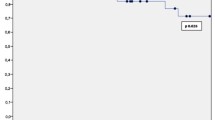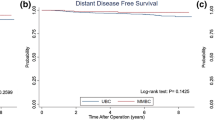Abstract
Background: The objective was to determine the impact of multicentric breast cancer on recurrence and survival and to evaluate the current tumor, node, metastasis staging system recommendations for multicentricity in the breast.
Methods: This study included 284 nonpregnant patients with T1-2, N0-1, M0 breast cancer, without previous cancer, who were treated by modified radical mastectomy followed by doxorubicin-based adjuvant chemotherapy. Clinical and pathological data were collected retrospectively and survival was calculated from the date of initial diagnosis using the Kaplan-Meier method.
Results: The median follow-up time was 8 years (range, 0.3–24.0), and the median age was 47 years (range, 23–76). The median clinical size of the index tumor was 2.5 cm. In 17% of patients, the clinical nodal status was N1. In 84% of patients, pathology of the index lesion was invasive ductal ± in situ. Multicentric breast cancer was detected in 60 patients (21%): 30 patients with two lesions, 13 patients with three lesions, and 17 patients with four or more lesions. Locoregional recurrence, contralateral breast cancer, distant metastasis, and survival (disease-specific and disease-free) were similar in both groups of multicentric versus unicentric breast tumors. There was a significant difference between groups in estrogen receptor and axillary lymph node positivity, but these did not contribute significantly to outcome on multivariate analysis.
Conclusions: Multicentricity does not increase the risk of poor outcomes in patients with early-stage breast cancer. This supports the current recommendations of the tumor, node, metastasis staging system that tumor size should be based on the diameter of the largest lesion in patients with multicentric breast cancer.
Similar content being viewed by others
References
Gallager HSD, Martin JE. The study of mammary carcinoma by mammography and whole organ sectioning: early observations.Cancer 1969;23:855–73.
Lagios MD. Multicentricity of breast carcinoma demonstrated by routine correlated serial subgross and radiographic examination.Cancer 1977;40:1726–34.
Cheatle GL, Cutler M.Tumors of the Breast: Their Pathology, Symptoms, Diagnoses and Treatment. Philadelphia: JB Lippincott, 1931.
Egan RL. Multicentric breast carcinomas: clinical-radiographic-pathologic whole organ studies and 10-year survival.Cancer 1982;49:1123–30.
McDivitt RW. Breast cancer multicentricity. In: McDivitt RW, Oberman HA, Ozzello L, et al., eds.The Breast. Baltimore: Williams & Wilkins, 1984:139–48.
Sarnelli R, Squartini F. Multicentricity in breast cancer: a submacroscopic study.Pathol Annu 1986;21(1):143–58.
Vaidya JS, Vyas JJ, Chinoy RF, et al. Multicentricity of breast cancer: whole-organ analysis and clinical implications.Br J Cancer 1996;74:820–4.
Fowble B, Yeh I-T, Schultz DJ, et al. The role of mastectomy in patients with stage I–II breast cancer presenting with gross multifocal or multicentric disease or diffuse microcalcifications.Int J Radiat Oncol Biol Phys 1993;27:567–73.
Anastassiades O, Iakovou E, Stavridou N, et al. Multicentricity in breast cancer: a study of 366 cases.Am J Clin Pathol 1993;99:238–43.
Spinelli C, Bert P, Ricci E, et al. Multicentric breast tumor: an anatomical-clinical study of 100 cases.Eur J Surg Oncol 1992;18:23–6.
American Joint Committee on Cancer. Breast. In:AJCC Cancer Staging Manual. 5th ed. Philadelphia: Lippincott-Raven, 1997:127–33.
Buzdar AU, Blumenschein GR, Smith TL, et al. Adjuvant chemotherapy with fluorouracil, doxorubicin, and cyclophosphamide, with or without Bacillus Calmette-Guérin and with or without irradiation in operable breast cancer: a prospective randomized trial.Cancer 1984;53:384–9.
Buzdar AU, Kau SW, Smith TL, et al. Ten-year results of FAC adjuvant chemotherapy trial in breast cancer.Am J Clin Oncol 1989;12(2):123–8.
Buzdar AU, Hortobagyi GN, Kau SW, et al. Adjuvant therapy with escalating doses of doxorubicin and cyclophosphamide with or without leukocyteα-interferon for stage II or III breast cancer.J Clin Oncol 1992;10:1540–6.
Buzdar AU, Hortobagyi GN, Kau SW, et al. Breast cancer adjuvant therapy at the M.D. Anderson Cancer Center—results of four prospective studies. In: Salmon SE, ed.Adjuvant Therapy of Cancer VII. Philadelphia: JB Lippincott, 1993:220–5.
Kemp BL. Breast specimen evaluation. In: Singletary SE, ed.Breast Cancer. (M.D. Anderson Solid Tumor Oncology Series.) New York: Springer-Verlag, 1999:120–31.
Kaplan EL, Meier P. Nonparametric estimation from incomplete observations.J Am Stat Assoc 1958;185:1457–81.
Cox DR. Regression models and life-tables.J Royal Stat Soc 1972;34:187–220.
Love SM, Barsky SH. Breast-duct endoscopy to study stages of cancerous breast disease.Lancet 1996;348:997–9.
Lesser ML, Rosen PP, Kinne DW. Multicentricity and bilaterality in invasive breast carcinoma.Surgery 1982;91:234–40.
Morgenstern L, Kaufman PA, Friedman NB. The case against tylectomy for carcinoma of the breast: the factor of multicentricity.Am J Surg 1975;130:251–8.
Kurtz JM, Jacquemier J, Amalric R. Breast-conserving therapy for macroscopically multiple cancers.Ann Surg 1989;212:38–44.
Fisher ER, Anderson S, Redmond C, et al. Ipsilateral breast tumor recurrence and survival following lumpectomy and irradiation: pathological finds from NSABP protocol B-06.Semin Surg Oncol 1992;8:161–6.
Fisher ER, Gregario R, Redmond C, et al. Pathologic findings from the National Surgical Adjuvant Breast Project (Protocol 4). Observations concerning the multicentricity of mammary cancer.Cancer 1975;35:247–54.
Westman-Naeser S, Bengtsson E, Eriksson O, et al. Multifocal breast carcinoma.Am J Surg 1981;142:255–7.
Mittra I. Axillary lymph node metastasis in breast cancer: prognostic indicator or lead-time bias?Eur J Cancer 1993;29:300–2.
Mittra I, MacRae KD. A meta-analysis of reported correlations between prognostic factors in breast cancer: does axillary lymph node metastasis represent biology or chronology.Eur J Cancer 1991;27:1574–83.
Fisher B, Bauer M, Wickerham DL, et al. Relation of number of positive axillary nodes to the prognosis of patients with primary breast cancer: an NSABP update.Cancer 1983;52:1551–7.
Author information
Authors and Affiliations
Rights and permissions
About this article
Cite this article
Vlastos, G., Rubio, I.T., Mirza, N.Q. et al. Impact of multicentricity on clinical outcome in patients with T1-2, N0-1, M0 breast cancer. Ann Surg Oncol 7, 581–587 (2000). https://doi.org/10.1007/BF02725337
Received:
Accepted:
Issue Date:
DOI: https://doi.org/10.1007/BF02725337




